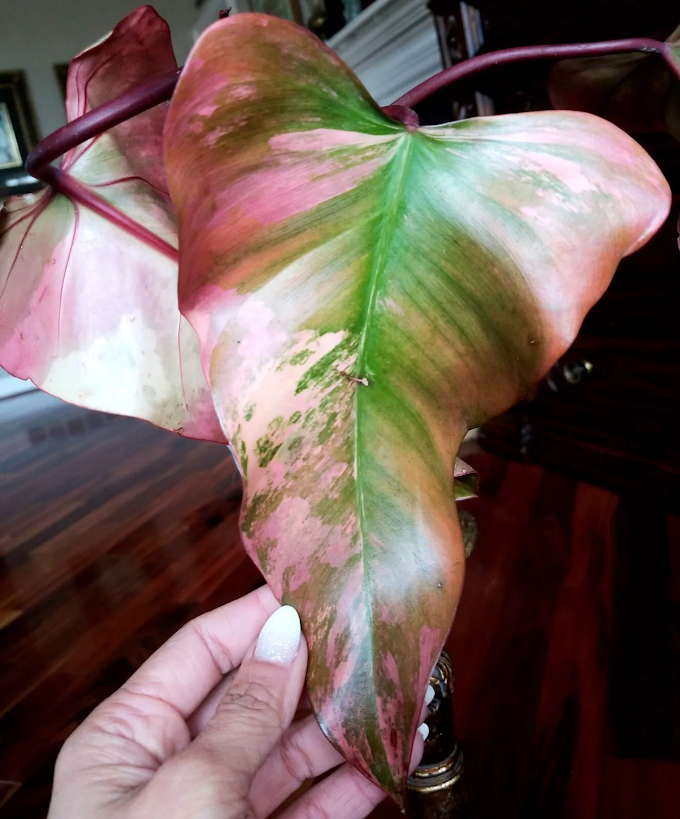Philodendron Strawberry: A Rare Jewel in the World of Tropical Plants
 Images @oiqycom
Images @oiqycom
In the lush, vibrant world of tropical plants, few specimens are as enchanting and visually striking as the Philodendron Strawberry. With its rare combination of hues, heart-shaped leaves, and resilient nature, this plant has captivated collectors and plant lovers around the world. But what makes the Philodendron Strawberry so special? How do you care for one, and why has it become a must-have in exotic plant collections? Let's delve deep into the fascinating universe of this botanical gem.
The Origins and Mystique of the Philodendron Strawberry
The Philodendron genus, with over 480 recognized species, is native to the tropical regions of Central and South America. The Philodendron Strawberry, believed to be a hybrid or a specially cultivated variety, derives its name from the soft strawberry-pink hue that adorns its newer leaves, especially when nurtured under optimal conditions.
Unlike some other philodendrons, the Strawberry variety is not widely available in the wild. Its charm lies largely in cultivation, where it has been selectively bred for its colorful displays. This makes the plant relatively rare and highly sought after among collectors who appreciate unique foliage.
Physical Appearance: A Play of Colors
What immediately sets the Philodendron Strawberry apart is its vibrant coloration. Young leaves emerge with shades ranging from soft pink to deep strawberry-red, gradually maturing into a blend of green with hints of blush. In the right lighting, the plant displays a stunning gradient effect across its foliage, creating an almost watercolor-like aesthetic.
The leaves are typically large, glossy, and heart-shaped, embodying the classic philodendron form but with a modern, colorful twist. The stems often carry a reddish tinge, adding further to the plant’s visual drama.
Caring for the Philodendron Strawberry
Though undeniably beautiful, the Philodendron Strawberry is not overly demanding in its care, making it an excellent choice even for intermediate plant enthusiasts. However, certain conditions must be met to maintain its vibrant coloration and healthy growth.
1. Light Requirements
Lighting plays a crucial role in the health and color of the Philodendron Strawberry. Ideally, it should be placed in bright, indirect light. Too much direct sunlight can scorch the leaves, fading their beautiful hues, while too little light may cause the pink tones to diminish, leading to greener, less striking foliage.
A spot near an east-facing or filtered south-facing window is ideal. Grow lights can also be used to supplement natural lighting, especially in homes with limited sunlight.
2. Watering and Humidity
As with many tropical plants, the Philodendron Strawberry thrives in moderate watering schedules. The soil should be allowed to dry out slightly between waterings. Overwatering is a common mistake and can lead to root rot—a deadly condition for philodendrons.
Humidity is another vital factor. These plants prefer a humid environment (around 60%–80%). In drier homes, using a humidifier or placing the pot over a pebble tray filled with water can help maintain optimal moisture levels in the air.
3. Soil and Fertilization
Well-draining, rich soil is best for the Philodendron Strawberry. A mix designed for aroids, typically containing peat, perlite, and orchid bark, will allow the roots to breathe and prevent waterlogging.
During the growing season (spring and summer), a balanced, diluted fertilizer can be applied monthly. Feeding helps to promote vigorous growth and enhances the color vibrancy of the leaves.
4. Temperature Needs
Being a tropical plant, the Philodendron Strawberry prefers warm temperatures ranging from 65°F to 80°F (18°C to 27°C). It should be kept away from cold drafts and sudden temperature changes, which can stress the plant and stunt its growth.
Propagation: Growing Your Collection
Propagation is possible through stem cuttings, and many enthusiasts enjoy multiplying their Strawberry Philodendrons to share with friends or expand their collections.
To propagate:
-
Choose a healthy stem with at least one node.
-
Cut using sterilized scissors.
-
Place the cutting in water or moist sphagnum moss until roots develop.
-
Once rooted, transplant into a well-draining potting mix.
Propagation success largely depends on maintaining high humidity and warmth, mimicking the plant’s native conditions.
Common Challenges and Solutions
Although generally hardy, the Philodendron Strawberry is susceptible to some common houseplant issues:
-
Pests: Spider mites, aphids, and mealybugs can occasionally infest the plant. Regularly inspect the undersides of leaves and treat any infestations promptly with insecticidal soap or neem oil.
-
Leaf Browning or Yellowing: This could be a sign of overwatering, underwatering, or too much direct sun.
-
Loss of Pink Color: Insufficient light is usually the culprit. Move the plant to a brighter location to restore its vibrant hues.
Keeping a close eye on the plant and adjusting its care as needed will prevent most problems before they become serious.
The Growing Popularity and Symbolism
In recent years, as indoor gardening has surged in popularity, colorful and unique plants like the Philodendron Strawberry have become coveted additions to plant collections. Beyond aesthetics, philodendrons are often associated with love, abundance, and personal growth, making them a meaningful gift as well as a beautiful décor item.
Social media platforms like Instagram and TikTok have only fueled the hype. Plant influencers often showcase their prized Strawberry Philodendrons, highlighting their beauty in curated plant shelfies and lush indoor jungles.
Conclusion: A Heartfelt Treasure
The Philodendron Strawberry is more than just a plant; it’s a statement of vibrancy, resilience, and rare beauty. Its unique coloration and relatively easy care requirements make it suitable for a wide range of plant lovers, from beginners seeking something special to seasoned collectors hunting for their next prized specimen.
Owning a Philodendron Strawberry is a rewarding experience, offering daily visual pleasure and the satisfaction of nurturing one of nature’s most charming creations. Whether displayed solo as a living piece of art or nestled among other tropical beauties, the Strawberry stands out—a symbol of the exquisite diversity and wonder that the plant world has to offer.

